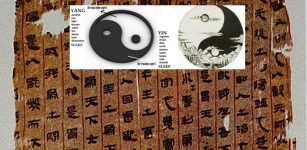Mystery Of The Coso Artifact: A Spark Plug Or A Genuine Example Of Advanced Antediluvian Technology?
A . Sutherland - AncientPages.com - Discoveries of man-made objects enclosed in pieces of rock or coal could possibly offer very persuasive evidence that in the "impossibly" remote past, mankind was significantly more advanced than we could even imagine.
One of such artifacts is the so-called Coso Artifact found inside a stone located near the top of a peak approximately 4,300 feet above sea level and about 340 feet above the dry bed of Owens Lake, California.
Is the Coso Artifact a genuine example of unknown advanced technology from millennia before the accepted emergence of Homo sapiens?
On February 13, 1961, Wallace Lane, Virginia Maxey and Mike Mikesell, co-owners of the LM&V Rockhounds Gem and Gift Shop in Olancha, California, were out in the Coso Mountains looking for minerals to sell in their shop.
The next day, while cutting through one of the geodes, Mikesell severely damaged a practically new diamond saw.
He expected to find crystals inside the stone, which he mistakenly identified as a geode.
Instead the stone contained something totally unfamiliar, namely, the remains of some form of mechanical device that resembled a spark plug.
This object became known as the Coso Artifact. Also the stone itself had some other strange qualities.
Beneath the outer layer of hardened clay, pebbles, and fossil inclusions was a hexagonal layer of an unidentifiable and very soft substance.
This layer surrounded a three-quarter-inch-wide cylinder made of solid porcelain or ceramic, and in the center of the cylinder, there was about .08 inches (two-millimeter) shaft of bright metal that was magnetic and showed no signs of oxidation. Also rings of copper circling the ceramic cylinder had not any signs of corrosion.
"X-rays taken of the fossil-encrusted rock revealed further evidence that the content of the "geode" was indeed some form of mechanical apparatus. The photographs indicated that the metallic shaft was corroded at one end, but the other end was affixed to a spring or helix of metal.
The Coso artifact, as it is now known, is believed to be more than just a piece of machinery. The finely shaped ceramic and metallic shaft and copper components hint at some form of electrical instrument. It bears a close resemblance to a spark plug, but there are certain features - particularly the spring or helix terminal - that do not correspond to any spark plug known today.
To complicate the mystery surrounding this strange little instrument, the geologists tell us that the rock in which it was found has to be at least half a million years old..." (R. Noorbergen, Secrets of the Lost Races).
Paul Wallis, publisher of paranormal magazine INFO Journal, examined the X rays of the mysterious object and concluded that it could be "the remains of a corroded piece of metal with threads," and noted its similarity to a modern spark plug.
However, Willis was still unable to understand the function of the spring on the object, which did not match up with contemporary spark plugs.
See also:
Gundestrup Cauldron: Great Gilded Silver Vessel Decorated With Scenes Derived From Celtic Mythology
Helmet Of Meskalamdug – Sumerian King Of The First Dynasty Of Ur
Enigma Of Ancient Bell-Shaped Metal Vase Found In Solid Sedimentary Rock
On September 29, 1999, Donald Chittick (The Institute for Creation Research) said about the Coso Artifact:
"My best guess is that it is probably early post-Flood. I have not yet been able to obtain sufficient documentation, so I don't say much publicly... It has not been my privilege to personally examine the Coso Artifact or location and strata where it was found. There are two reasons I considered the Artifact significant.
It obviously is a man-made item... Those who evaluated the strata said that it appeared to be old, not modern strata. Those two items are the principle basis for my conclusion that it was worth study. Certainly it does merit further study in my judgment. Numerous items like that abound, but I haven't been able to document them as thoroughly as I would like, and so I don't say too much about them..."
Some argued that the artifact was not inside a geode at all, but encased in hardened clay and it's nothing more than a 1920s spark plug.
If so, how did it get inside a 500,000-year-old rock?
"The controversy in which these finds are enveloped concerns the dates that have been assigned to them because of the strata in which they were discovered. No conscientious geologist will dare attach any degree of certainty to the various dates given to the different layers of the earth's crust, " says Noorbergen.
"It is more reasonable to look at the artifacts in the light of Deluge geology, which maintains that the stratified rock is the result of soil laid down by water.
This signifies that the metal objects encased in the rocks were buried during the Flood, and thus their manufacture would date from before the Deluge.
The ooparts certainly set the theories of the geologists against those of the historians, for one group holds stubbornly to the million-year-age theory, and the orthodox historians definitely are unwilling to accept the authenticity of a machine-made cube in a block of coal dating back to the Tertiary period..."
"Because the Coso artifact was found in sedimentary rock, we must conclude that this was deposited during the great Flood. What makes these artifacts significant to us is that they reveal that the antediluvians had progressed beyond mere metal production and had obviously learned how to utilize certain forms of energy - in this case electricity - several thousand years before the reintroduction of this knowledge into our civilization..." continues Noorbergen
In 1963, the artifact was apparently on displayed for three months at the Eastern California Museum in Independence.
After 1969 the Coso Artifact has disappeared. It cannot be thoroughly examined and the mystery surrounds its whereabouts.
In September 1999, a national search undertaken to trace any of the original discoverers of this controversial artifact, proved unsuccessful. It seems likely that by then Lane had died and the whereabouts of Mikesell were unknown. Regarding Virginia Maxey, it is known she is still living but refuses to comment publicly about the artifact.
Written by – A. Sutherland - AncientPages.com Senior Staff Writer
Copyright © AncientPages.com All rights reserved. This material may not be published, broadcast, rewritten or redistributed in whole or part without the express written permission of AncientPages.com
More From Ancient Pages
-
 Sumerian Stele Of The Vultures: Oldest Known Historical Records Carved On Limestone
Featured Stories | Sep 1, 2016
Sumerian Stele Of The Vultures: Oldest Known Historical Records Carved On Limestone
Featured Stories | Sep 1, 2016 -
 Mystery Of The Black Irish People: Who Were They?
Civilizations | May 24, 2016
Mystery Of The Black Irish People: Who Were They?
Civilizations | May 24, 2016 -
 Discovery Of An Unusually Large Ancient Artifact May Confirm Powerful Myth Of A Mysterious Race
Featured Stories | Oct 8, 2024
Discovery Of An Unusually Large Ancient Artifact May Confirm Powerful Myth Of A Mysterious Race
Featured Stories | Oct 8, 2024 -
 Monumental Fortification That Protected The Kings Of Jerusalem Unearthed In The City Of David
Archaeology | Jul 23, 2024
Monumental Fortification That Protected The Kings Of Jerusalem Unearthed In The City Of David
Archaeology | Jul 23, 2024 -
 America’s Mysterious Waffle Rock Formation
Featured Stories | Apr 15, 2014
America’s Mysterious Waffle Rock Formation
Featured Stories | Apr 15, 2014 -
 Ancient Manuscript In Museum Reveals Discovery Of Objects Unknown To Modern Science – Coptic Secrets And Guardians Of Treasures – Part 2
Featured Stories | Apr 11, 2021
Ancient Manuscript In Museum Reveals Discovery Of Objects Unknown To Modern Science – Coptic Secrets And Guardians Of Treasures – Part 2
Featured Stories | Apr 11, 2021 -
 Skull Of Mysterious, Extinct Cousin Of Neanderthals Recreated From A Fossilized Finger
Archaeology | Sep 19, 2019
Skull Of Mysterious, Extinct Cousin Of Neanderthals Recreated From A Fossilized Finger
Archaeology | Sep 19, 2019 -
 Previously Uncounted Copies Of Newton’s Groundbreaking ‘Principia’ – Discovered
News | Nov 11, 2020
Previously Uncounted Copies Of Newton’s Groundbreaking ‘Principia’ – Discovered
News | Nov 11, 2020 -
 Treasure Hunters Encounter Something Unexplained In The Arizona Mountains
Featured Stories | Apr 7, 2022
Treasure Hunters Encounter Something Unexplained In The Arizona Mountains
Featured Stories | Apr 7, 2022 -
 Time Capsule – Best Preserved 3,000-Year-Old Dwelling Ever Found In Britain
Archaeology | Jan 12, 2016
Time Capsule – Best Preserved 3,000-Year-Old Dwelling Ever Found In Britain
Archaeology | Jan 12, 2016 -
 Is A Viking Settlement And Even Older Church Hidden Under St. Clement’s Church In Norway?
Archaeology | Apr 13, 2017
Is A Viking Settlement And Even Older Church Hidden Under St. Clement’s Church In Norway?
Archaeology | Apr 13, 2017 -
 Stolen Antique Tamil Nadu Statues Have Been Returned By Britain To India
Artifacts | Sep 23, 2020
Stolen Antique Tamil Nadu Statues Have Been Returned By Britain To India
Artifacts | Sep 23, 2020 -
 Is A Small Obsidian Artifact Linked To Expedition Searching For A Fabled City Of Gold 470 Years Ago?
Archaeology | Mar 1, 2024
Is A Small Obsidian Artifact Linked To Expedition Searching For A Fabled City Of Gold 470 Years Ago?
Archaeology | Mar 1, 2024 -
 Ancient Coffin Of Priest Psamtik, Son Of Osiris And Five Replicas Of Goddess Maat Sent On Upcoming Expo
Archaeology | Oct 5, 2021
Ancient Coffin Of Priest Psamtik, Son Of Osiris And Five Replicas Of Goddess Maat Sent On Upcoming Expo
Archaeology | Oct 5, 2021 -
 Dark History Of Pömmelte, The German Stonehenge – What Can The Nebra Sky Disc And Archaeology Reveal?
Archaeology | Jul 3, 2018
Dark History Of Pömmelte, The German Stonehenge – What Can The Nebra Sky Disc And Archaeology Reveal?
Archaeology | Jul 3, 2018 -
 Rudolf II: Eccentric Holy Roman Emperor Whose Occult Interest And Mistakes Led To The Thirty Years’ War
Featured Stories | Apr 9, 2021
Rudolf II: Eccentric Holy Roman Emperor Whose Occult Interest And Mistakes Led To The Thirty Years’ War
Featured Stories | Apr 9, 2021 -
 Mawangdui Medical Manuscripts: Oldest Surviving Anatomical Atlas In The World
News | Sep 2, 2020
Mawangdui Medical Manuscripts: Oldest Surviving Anatomical Atlas In The World
News | Sep 2, 2020 -
 Ancient DNA Reveals How Yamnaya People Re-Wrote Northern Europeans’ Genetic Story 5,000 Years Ago
DNA | Jan 12, 2024
Ancient DNA Reveals How Yamnaya People Re-Wrote Northern Europeans’ Genetic Story 5,000 Years Ago
DNA | Jan 12, 2024 -
 Unique 2700-Year-Old Papyrus With Inscription In Paleo-Hebrew Acquired By Israel From U.S
Archaeology | Sep 7, 2022
Unique 2700-Year-Old Papyrus With Inscription In Paleo-Hebrew Acquired By Israel From U.S
Archaeology | Sep 7, 2022 -
 Unsolved Mystery Of The Aleppo Codex And Its Missing Pages: One Of The World’s Most Precious Ancient Books
Artifacts | Feb 27, 2017
Unsolved Mystery Of The Aleppo Codex And Its Missing Pages: One Of The World’s Most Precious Ancient Books
Artifacts | Feb 27, 2017


